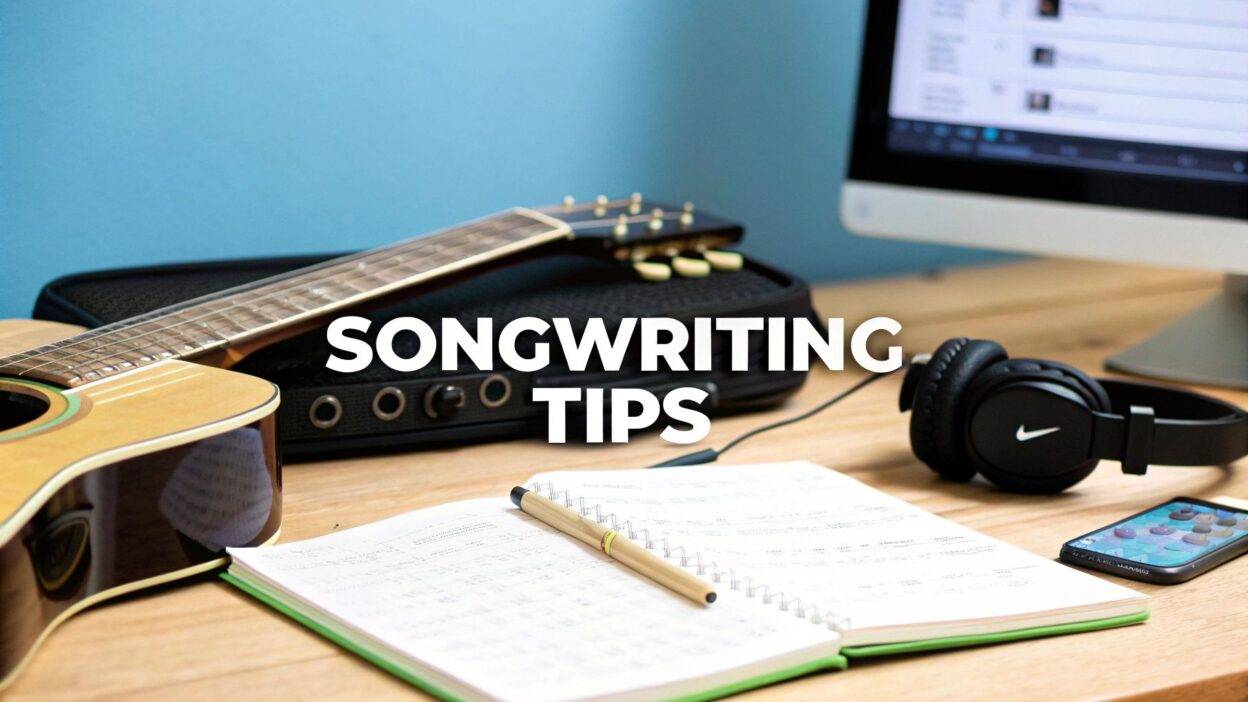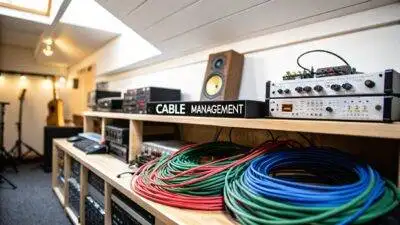From Silent Pages to Sonic Masterpieces: Your Songwriting Journey Starts Now
Welcome to the world of songwriting, where your thoughts, feelings, and stories transform into music that can connect with listeners across the globe. For many aspiring musicians and independent artists, the process can seem daunting. A blank page or an empty digital audio workstation (DAW) session can feel intimidating. Where do you begin? How do you turn a fleeting idea into a complete, polished song? The truth is, every legendary songwriter started exactly where you are now, with a passion for music and a desire to create.
This guide is designed to demystify the process and provide a clear, actionable roadmap. We have compiled a comprehensive list of essential songwriting tips for beginners that will equip you with the foundational skills, habits, and mindset needed to craft compelling music. These are not vague theories; they are practical techniques used by professional songwriters, broken down into simple steps you can apply immediately to your work.
From structuring your verses and choruses to developing powerful lyrical themes, this article will cover the core components of great songwriting. You will learn how to:
- Craft memorable hooks and melodies.
- Build a consistent writing routine.
- Analyze the work of your favorite artists to improve your own.
- Overcome creative blocks and refine your workflow.
Whether your goal is to write a simple acoustic ballad, produce a complex electronic track, or simply find a better way to express your musical ideas, these principles will serve as your creative compass. This guide is your first step toward unlocking your potential and turning silent pages into sonic reality.
1. Start with a Strong Hook
A song’s hook is its most magnetic element, the part that instantly grabs a listener's attention and refuses to let go. It's the musical or lyrical phrase that gets stuck in your head, making the song memorable long after it has finished playing. While often found in the chorus, a great hook can appear anywhere: a distinctive intro, a compelling verse line, or a catchy instrumental riff. This is one of the most crucial songwriting tips for beginners because a strong hook provides a solid foundation to build the rest of your track around.
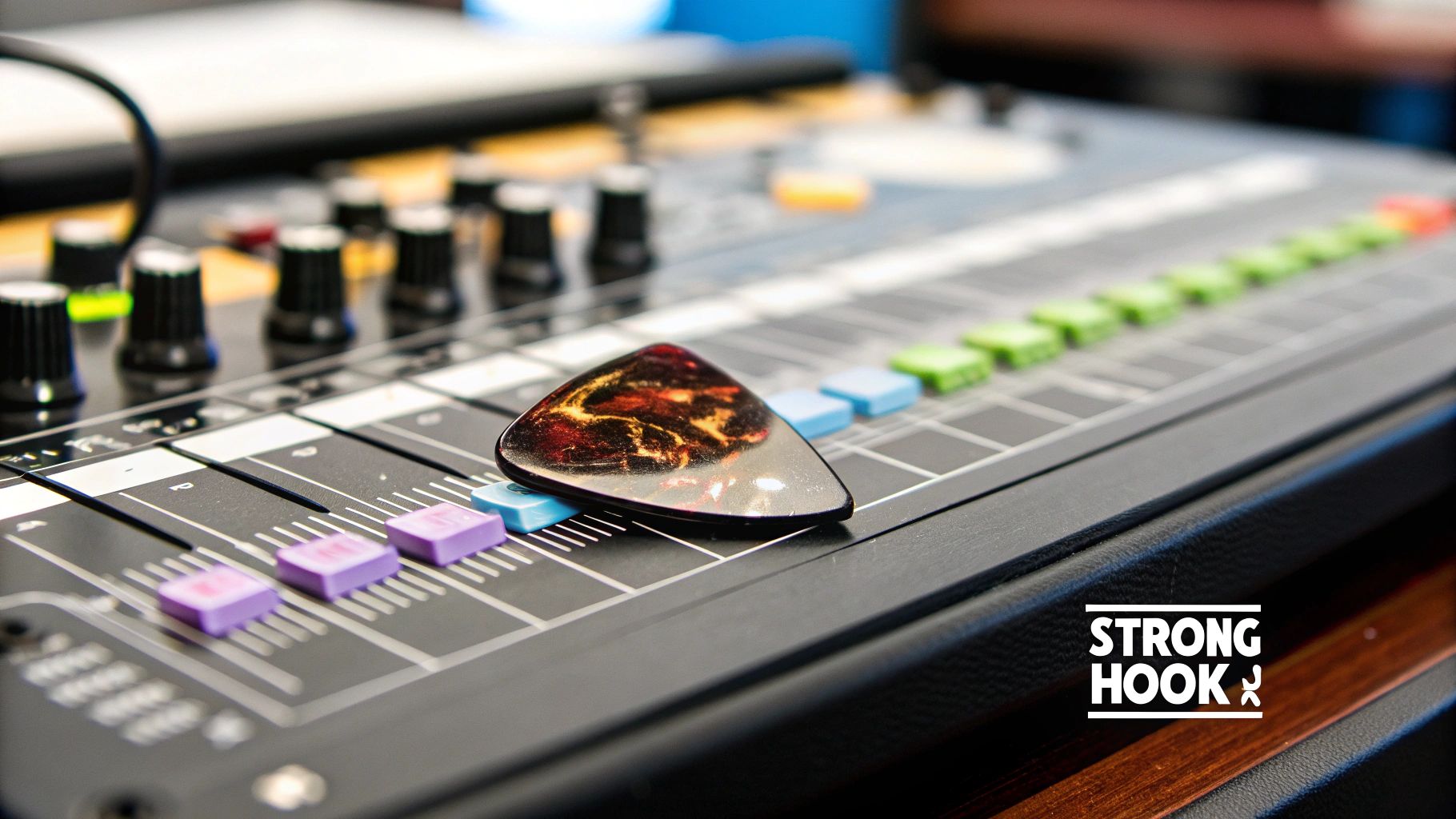
Think of the iconic opening guitar riff in The White Stripes' "Seven Nation Army" or the simple, unforgettable piano motif in Adele's "Someone Like You." These are not just melodies; they are musical statements that define the entire song. A hook can also be lyrical, like the instantly recognizable opening line, "Hello, is it me you're looking for?" from Lionel Richie's "Hello." These elements are powerful because they are simple, repetitive, and emotionally resonant.
How to Create a Compelling Hook
Developing the skill to create hooks is essential for any aspiring songwriter. It’s a craft that combines intuition with intentional practice. Here are some actionable ways to discover and refine your own hooks:
- Embrace Voice Memos: Inspiration is unpredictable. Keep your phone's voice recorder handy to capture melodic ideas or lyrical phrases as they come to you, whether you're on a walk, in the shower, or doing chores. Don't judge the idea; just capture it.
- Analyze Hit Songs: Actively listen to your favorite popular songs and deconstruct their hooks. What makes them so effective? Is it the melody's shape, the rhythm, the instrumentation, or a specific lyrical turn of phrase? Understanding what works for others can inspire your own unique approach.
- Keep It Simple and Singable: The most effective hooks are often the simplest. They use a limited number of notes and have a clear, easy-to-follow rhythm. A good test is whether someone can hum it back to you after hearing it just once or twice.
- Test Your Ideas: Before you commit to building an entire song around a hook, play it for a friend or family member. Their immediate reaction can be a valuable indicator of whether the hook has the "stickiness" you're aiming for. This early feedback can save you time and help you focus your creative energy on your strongest ideas.
2. Use the Verse-Chorus Structure
The verse-chorus structure is the bedrock of modern popular music, providing a familiar and satisfying framework for both the songwriter and the listener. It creates a powerful dynamic by alternating between verses, which typically advance the narrative or set the scene, and a repetitive chorus, which delivers the song's central message and emotional core. For those just starting out, mastering this format is one of the most effective songwriting tips for beginners because it offers a proven blueprint for creating songs that are coherent, engaging, and memorable.
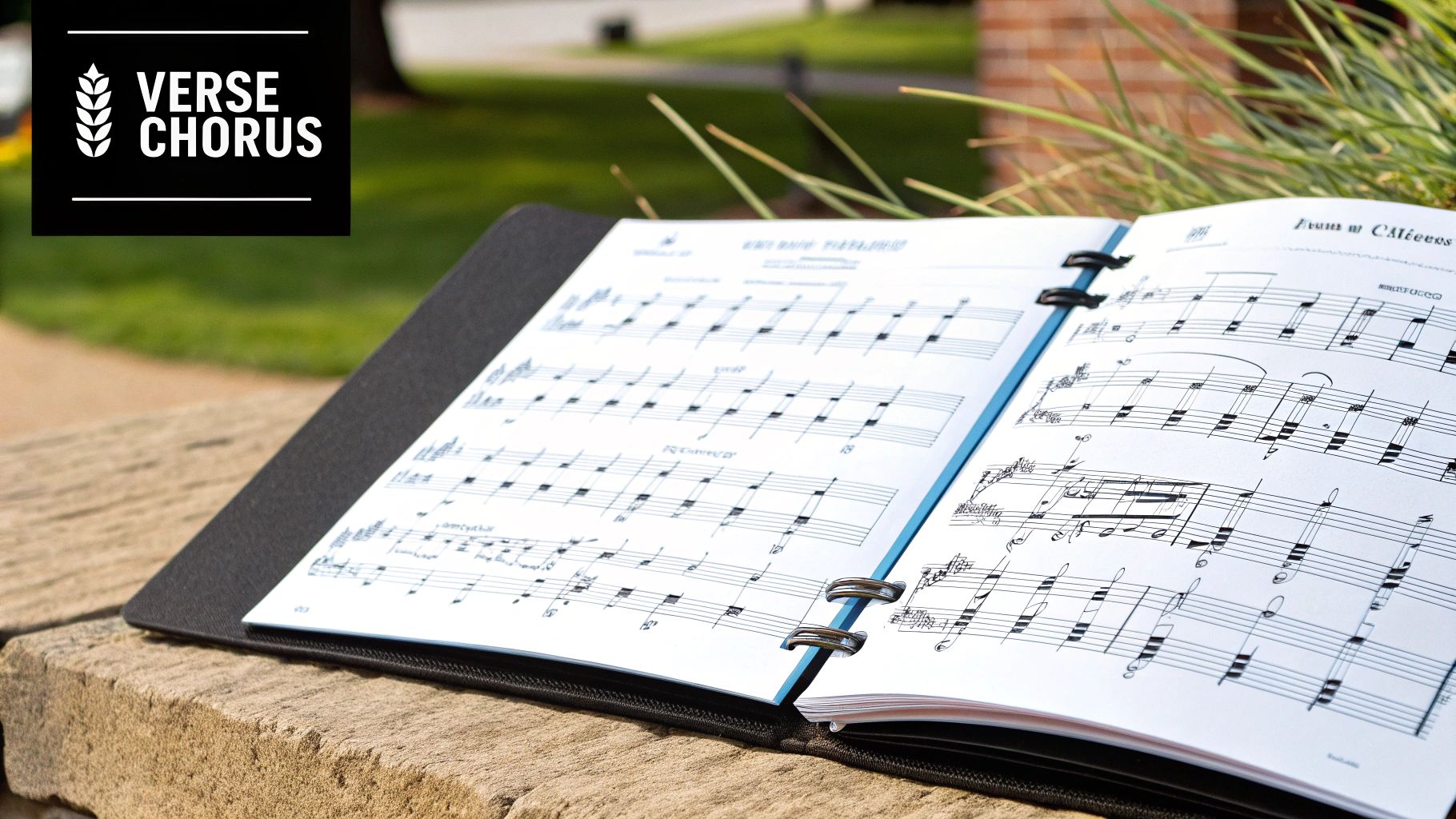
This structure’s effectiveness lies in its balance of novelty and repetition. The verses keep the listener engaged with new details and storytelling, while the returning chorus provides a comforting and catchy anchor point. Think of Taylor Swift’s "Shake It Off," where the verses tell a story of facing criticism, and the explosive chorus delivers the simple, empowering mantra. Similarly, Beyoncé's "Crazy in Love" uses conversational verses to describe infatuation before erupting into an iconic, high-energy chorus that captures the feeling itself. This structure provides a clear path for emotional and musical development.
How to Effectively Use Verse-Chorus Structure
Building a song with this structure is about more than just alternating sections; it’s about making each part serve a distinct purpose while contributing to a cohesive whole. Here are some actionable ways to implement this structure in your own songs:
- Create Dynamic Contrast: Make your sections feel distinct. A common technique is to have verses that are more rhythmically sparse, melodically conversational, and lyrically detailed. In contrast, make the chorus more expansive and energetic with a soaring, memorable melody and simpler, impactful lyrics.
- Use a Pre-Chorus to Build Tension: The pre-chorus is a short section that connects the verse to the chorus. Its job is to create anticipation. You can achieve this by changing the chords, increasing the rhythmic intensity, or raising the melody to signal that a big moment (the chorus) is about to arrive.
- Keep the Chorus Simple: The chorus is the part you want everyone to sing along to. Its lyrics and melody should be direct, easy to grasp, and emotionally resonant. Avoid cramming too many complex ideas or words into it. The goal is instant impact and memorability.
- Write Multiple Verses: Don’t settle for the first verse you write. Draft two or three different versions that explore different angles of your story. This allows you to select the strongest lyrical ideas and ensure your narrative progresses compellingly from the first verse to the second.
3. Keep It Simple and Relatable
Some of the most powerful songs in history are built on a foundation of simplicity and relatability. This approach means using clear, direct language and straightforward musical ideas that allow your core message to connect deeply with the listener. Relatability comes from tapping into universal human experiences, emotions, and stories that resonate on a personal level. For new songwriters, this is one of the most effective songwriting tips for beginners because it removes the pressure to be overly complex and instead focuses on honest, impactful communication.
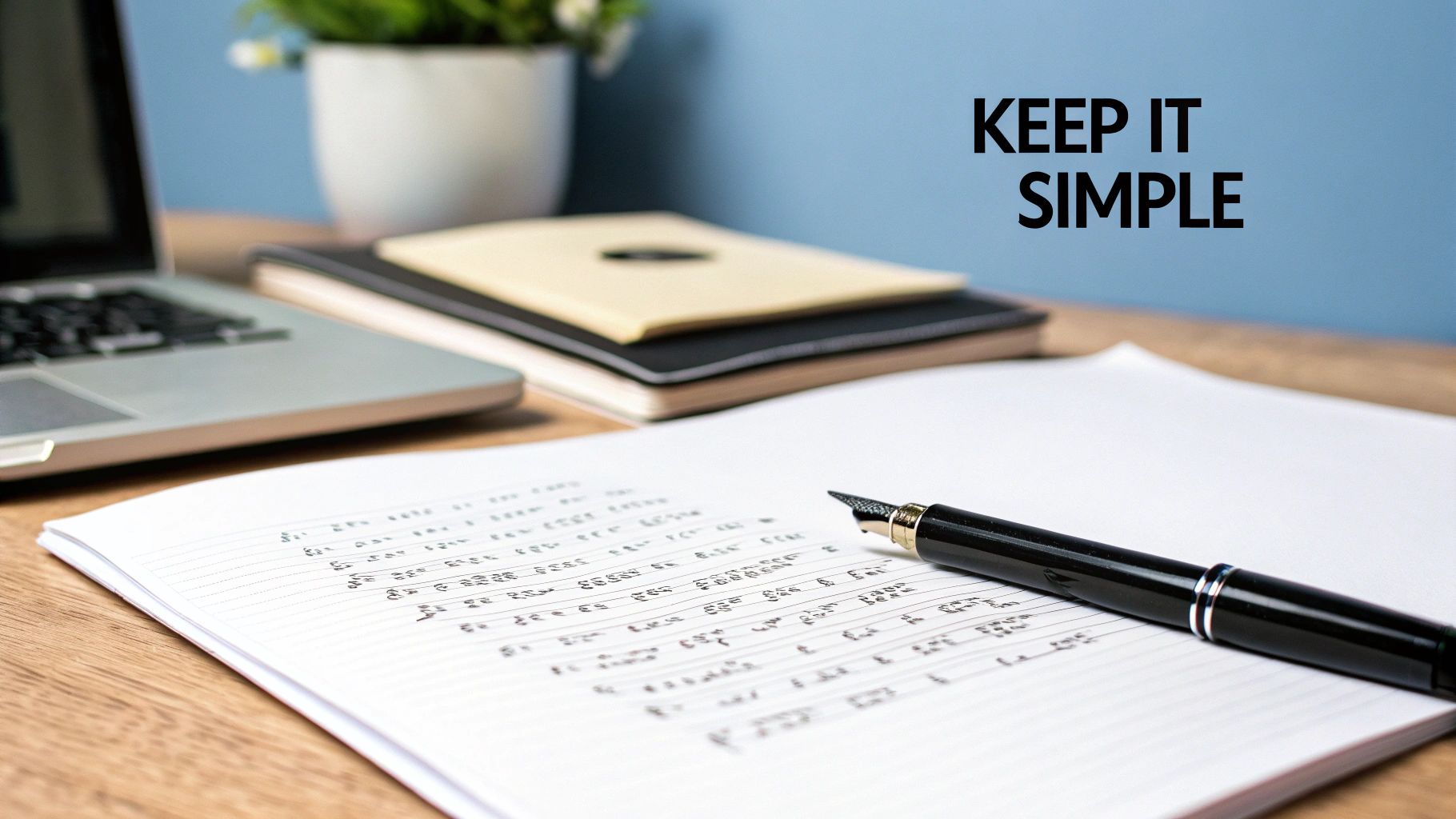
Think of Dolly Parton's "Jolene," a masterclass in simplicity. The story is direct: a woman pleading with another not to take her man. Its emotional power comes from the raw, relatable fear of jealousy and loss, not from complex poetry or intricate chords. Similarly, John Lennon's "Imagine" conveys a profound message of peace using simple piano chords and accessible, idealistic language. These songs prove that you don't need lyrical acrobatics or musical complexity to create something timeless; you need a genuine idea that speaks to the heart.
How to Write Simple and Relatable Songs
Making your music accessible is not about "dumbing it down"; it's about sharpening your focus to deliver a potent emotional experience. This skill involves stripping away the non-essential to reveal the powerful core of your idea. Here are some practical ways to write with simplicity and relatability:
- Write Like You Talk: Avoid overly poetic or abstract language that distances you from the listener. Use conversational phrases and everyday words. A great test is to speak your lyrics out loud. If they sound unnatural or awkward, they will likely feel that way in the song.
- Focus on One Core Emotion: A song that tries to be about everything often ends up being about nothing. Center your lyrics around a single, specific feeling like joy, regret, longing, or anger. This singular focus makes the emotional journey clearer and more impactful for the listener.
- Use Specific Details for Universal Themes: To make a universal theme like love or loss feel personal, ground it in specific, sensory details. Instead of saying "I miss you," describe the empty coffee cup they left behind or the scent of their jacket. These small, tangible details make the broader emotion feel real and relatable.
- Draw from Your Own Experiences: The most authentic and relatable stories come from your own life. Write about what you know and what you've felt. Your personal vulnerability is a powerful tool; if you've experienced an emotion, chances are millions of others have too.
4. Write Regularly and Set Goals
Songwriting is a craft, and like any craft, it requires consistent practice to develop and maintain proficiency. Waiting for unpredictable flashes of inspiration is one of the biggest hurdles for aspiring musicians. Instead, treating songwriting as a regular discipline builds creative muscle, making it easier to generate ideas on demand. This is one of the most vital songwriting tips for beginners because it transforms a hobby into a sustainable creative practice, ensuring continuous growth and preventing creative blocks.

This principle is championed by some of history’s most prolific artists. Paul McCartney famously maintained a routine of daily piano sessions to keep his melodic instincts sharp. Similarly, Lin-Manuel Miranda is known for his dedicated morning writing routine, which was crucial for completing complex projects like Hamilton. Even Bob Dylan's legendary career is marked by periods of intense, consistent output. These examples show that regular, structured effort is often the secret ingredient behind great artistry, proving that quantity can lead to quality.
How to Build a Consistent Writing Habit
Developing a routine turns the abstract goal of "becoming a better songwriter" into a series of manageable, concrete actions. It's about creating a system that supports your creativity rather than waiting for it to strike. Here are some practical ways to integrate regular writing into your life:
- Set a Small, Daily Commitment: You don’t need to write a full song every day. Start with a realistic goal, like dedicating just 15-30 minutes to songwriting. Use this time to brainstorm lyrics, hum melodies into your phone, or simply play with chord progressions. The consistency is more important than the duration.
- Use Songwriting Prompts and Challenges: When you feel stuck, external prompts can provide a much-needed spark. Participate in challenges like February Album Writing Month (FAWM) or use online prompt generators. These tools remove the pressure of finding an initial idea and get you straight into the act of creating.
- Keep a Songwriting Journal: Dedicate a physical notebook or a digital document to all your song-related ideas. This includes lyrical snippets, chord progressions, song titles, and conceptual thoughts. Reviewing it regularly can help you connect disparate ideas and find inspiration within your own work.
- Establish Clear, Achievable Goals: Instead of a vague goal like "write more," set specific targets. For example, aim to complete one full song per month or finish three lyrical drafts per week. Tracking your progress on a calendar or with an app provides a sense of accomplishment and keeps you motivated.
5. Study Your Favorite Songs
One of the most powerful and accessible songwriting tips for beginners is to become a student of the music you admire. Studying your favorite songs is like taking a masterclass from the artists who inspire you. It involves moving beyond passive listening and actively dissecting the elements that make a song work. By reverse-engineering successful tracks, you gain invaluable insights into structure, melody, harmony, and lyrical storytelling, building a mental toolbox of techniques you can adapt for your own creations.
This practice is a time-honored tradition among the world's greatest musicians. The Beatles famously honed their craft by deconstructing the songs of Chuck Berry and Little Richard, while Adele’s soulful phrasing is deeply informed by her study of legends like Etta James and Aretha Franklin. More modern examples include Ed Sheeran, who analyzed the narrative style of Damien Rice and the rhythmic delivery of Eminem, and Billie Eilish, whose unique sound is influenced by artists as diverse as Tyler, The Creator and Lana Del Rey. These artists didn't just listen; they learned the "why" behind the magic.
How to Analyze a Song Effectively
Transforming your listening sessions into productive study requires a systematic approach. The goal is to understand the deliberate choices the songwriter and producer made. Here are a few practical methods to start analyzing music like a pro:
- Map the Song's Structure: Listen to a song with a pen and paper (or a blank document) and map out its architecture. Label each section as it happens: Intro, Verse 1, Pre-Chorus, Chorus, Verse 2, Chorus, Bridge, Guitar Solo, Chorus, Outro. This visual blueprint reveals how the song builds tension and release, and how it keeps the listener engaged.
- Transcribe Lyrics and Chords: Write out the lyrics and use tools like Ultimate Guitar or Chordify to find the chord progressions. Pay attention to how the chords support the melody and how the emotional tone of the music aligns with the lyrical themes. Notice which words are emphasized by melodic leaps or harmonic changes.
- Identify Emotional Peaks: Pinpoint the moments in the song that give you chills or make you feel the most emotion. Is it a change in the dynamics, the addition of a new instrument, a powerful vocal harmony, or a particularly poignant lyric? Understanding how these peaks are constructed is key to creating them in your own music.
- Explore Different Genres: Don't limit your analysis to your favorite genre. Studying pop, folk, hip-hop, and classical music can expose you to different structural conventions, harmonic languages, and rhythmic ideas. This cross-pollination is a fantastic source of fresh inspiration for your own work. By breaking down the components of great songs, you move from being a fan to being a craftsperson, a vital step in your journey. For more guidance on this process, you can find a wealth of information in guides on songwriting for dummies.
6. Collaborate with Others
Songwriting doesn't have to be a solitary journey. Collaboration involves working with other writers, musicians, or producers to create music together, blending unique skills and perspectives. This process can spark new ideas and push you beyond your creative comfort zone, often resulting in a song that is more polished and dynamic than what you might have created alone. For beginners, it's a powerful way to learn, grow, and build connections within the music community.
History is filled with legendary songwriting partnerships that demonstrate the power of collaboration. The iconic duo of John Lennon and Paul McCartney in The Beatles, the timeless lyrics of Bernie Taupin paired with Elton John's melodies, and the hit-making machine of Nashville's co-writing culture all showcase how combining creative forces can lead to extraordinary results. Even today, top artists like Beyoncé and Taylor Swift work with teams of co-writers to craft their chart-topping albums.
How to Effectively Collaborate
Finding the right creative partner and establishing a productive workflow are key to a successful collaboration. This approach can inject fresh energy into your process and is one of the most effective songwriting tips for beginners looking to expand their skills. Here’s how to get started:
- Define Roles and Expectations: Before you start writing, have an open conversation about roles, goals, and how you will handle creative differences. Decide who is focusing on lyrics, melody, or production. Also, be sure to document contributions and agree on songwriting splits early to avoid conflicts later.
- Be Open and Respectful: The magic of collaboration comes from the fusion of different ideas. Be prepared to listen, compromise, and build upon your partner’s contributions. Avoid shooting down ideas immediately; instead, explore them and see where they lead. A positive and respectful environment fosters creativity.
- Use Online Collaboration Tools: You don't need to be in the same room to write a song. Platforms like BandLab, Kompoz, or even simple cloud-based documents allow you to work with musicians from anywhere in the world. These tools make it easy to share audio files, write lyrics together, and build a track remotely.
- Start with People You Know: Your first collaboration doesn't have to be with a stranger. Reach out to musically inclined friends or local musicians at a similar skill level. Attending open mic nights or joining local songwriter groups can also be a great way to meet potential creative partners. To explore this topic further, you can learn more about how to collaborate with others on chordx.io.
7. Don't Overthink the Process
Analysis paralysis is a common enemy for any creative, but it can be especially crippling for a new songwriter. Overthinking the process means constantly critiquing, judging, and attempting to perfect every lyric, chord, and melody as it comes to you. This internal critic can stifle the raw, spontaneous energy that often leads to the most authentic and compelling songs. One of the most vital songwriting tips for beginners is learning to separate the creative act from the editing act, allowing ideas to flow freely without immediate judgment.
Think of Kurt Cobain’s stream-of-consciousness approach to lyrics for Nirvana, which often prioritized emotional impact over precise narrative clarity. Similarly, Prince was legendary for his prolific output, frequently writing and recording entire songs in a single burst of inspiration, capturing the magic of the moment. Even the initial lo-fi recordings for Bon Iver's For Emma, Forever Ago are beloved for their raw, unpolished honesty, a quality that might have been lost with excessive refinement. These examples show that the initial creative spark is precious and needs room to breathe.
How to Silence Your Inner Critic
Cultivating a free-flowing creative mindset is a skill that requires conscious practice. The goal is to create a space where your ideas can be born without fear of immediate rejection. Here are some actionable strategies to help you stop overthinking and start writing:
- Set a Timer: Challenge yourself to write for a short, focused period, like 15 or 20 minutes, without stopping to edit. This technique, known as a "creative sprint," forces you to keep moving forward and prevents you from getting bogged down in minor details.
- Embrace the Rough Draft: Give yourself permission to write a "bad" first version of a song. The objective is simply to get a complete idea down on paper or recorded. You can always go back and polish it later. The initial draft is just the clay; the sculpting comes in the editing phase.
- Practice Stream of Consciousness: Grab a notebook and write continuously for ten minutes without lifting your pen. Don't worry about grammar, sense, or structure. This exercise helps disconnect the critical part of your brain and can unearth surprising lyrical phrases and concepts.
- Capture and Move On: Use voice memos on your phone to quickly capture melodic or lyrical snippets the moment they appear. Don't analyze them; just record the idea and return to your day. This habit ensures you never lose a fleeting moment of inspiration and keeps the creative process fluid.
8. Use Rhyme Schemes and Rhythm Patterns
Rhyme schemes and rhythm patterns are the architectural blueprints for your lyrics. They provide the structural integrity that makes a song’s words feel cohesive, memorable, and satisfying to the ear. A well-chosen rhyme scheme, like the classic ABAB or AABA, creates a sense of predictability and order, guiding the listener’s ear and helping them anticipate and remember the lyrics. Rhythm, on the other hand, dictates how those words flow over the music, ensuring they fit the song's meter and feel natural rather than forced.
Think of the simple, effective AABB rhyme scheme in The Beatles' "Love Me Do," which makes the lyrics instantly singable. Contrast that with the complex internal and multi-syllabic rhymes used by artists like Eminem or Kendrick Lamar, where rhythm and rhyme become a percussive instrument in themselves. These elements are a fundamental part of the toolkit for any beginner songwriter because they transform simple lines of text into a musical and lyrical experience that connects with the listener on a deeper level.
How to Implement Rhyme and Rhythm Effectively
Mastering the interplay of rhyme and rhythm is a crucial step in elevating your songwriting from good to great. It’s about more than just finding words that sound alike; it's about crafting a sonic texture that enhances your song's message. Here are some practical ways to get started:
- Start with Simple Patterns: Don't feel pressured to write like a rap god on day one. Begin with common patterns like AABB (where the first two lines rhyme, and the next two rhyme) or ABAB (where the first and third lines rhyme, and the second and fourth rhyme). These foundational structures will teach you the discipline of lyrical construction.
- Utilize Rhyming Tools: There's no shame in using a rhyming dictionary or a digital tool like RhymeZone. These resources can expand your vocabulary and help you find the perfect word that fits both the rhyme and the meaning of your line. Over time, you'll rely on them less as your own mental rhyming dictionary grows.
- Read Your Lyrics Aloud: This is one of the most vital songwriting tips for beginners. Reading your lyrics out loud, without music, is the best way to test their natural rhythm and flow. If you stumble over a line or it sounds awkward, it’s a clear sign that the rhythm needs adjustment. Clap out the beat as you say the words to ensure they fit a consistent meter.
- Study the Masters of Rhythm: To truly understand the power of lyrical rhythm, listen actively to genres that prioritize it, like hip-hop and folk. Analyze how rappers like J. Cole structure their verses or how folk storytellers like Bob Dylan use rhyme to drive a narrative. You can discover more about the different types of rhyme schemes in songs to broaden your creative palette.
Top 8 Songwriting Tips Comparison
| Technique | Implementation Complexity 🔄 | Resource Requirements ⚡ | Expected Outcomes 📊 | Ideal Use Cases 💡 | Key Advantages ⭐ |
|---|---|---|---|---|---|
| Start with a Strong Hook | Medium 🔄🔄 | Moderate ⚡⚡ | High engagement, memorability 📊📊 | Songs needing immediate listener capture | Grabs attention fast; sets tone ⭐⭐ |
| Use the Verse-Chorus Structure | Low 🔄 | Low ⚡ | Familiar, clear song framework 📊 | Commercial/pop genres; accessible songwriting | Easy to learn; industry standard ⭐⭐ |
| Keep It Simple and Relatable | Low 🔄 | Low ⚡ | Broad emotional connection 📊 | Songs aiming for wide audience relatability | Easy sing-along; authentic connection ⭐ |
| Write Regularly and Set Goals | Medium 🔄🔄 | Time investment ⚡⚡ | Skill improvement and productivity 📊 | Building songwriting discipline and volume | Builds confidence; generates ideas ⭐⭐ |
| Study Your Favorite Songs | Medium 🔄🔄 | Research tools, time ⚡⚡ | Enhanced songwriting insight 📊 | Learning songwriting techniques and styles | Learn from success; develops style ⭐⭐ |
| Collaborate with Others | High 🔄🔄🔄 | Network and coordination ⚡⚡⚡ | Diverse creative output 📊📊 | Enhancing creativity through teamwork | Combines strengths; accelerates learning ⭐⭐⭐ |
| Don't Overthink the Process | Low 🔄 | Minimal ⚡ | Maintains creative flow 📊 | Overcoming writer’s block; preserving authenticity | Encourages spontaneity; reduces anxiety ⭐ |
| Use Rhyme Schemes and Rhythm Patterns | Medium 🔄🔄 | Moderate (tools/apps) ⚡⚡ | Catchy, memorable lyrics 📊📊 | Creating structured, impactful lyrics | Enhances flow and musicality; memorable ⭐⭐ |
Now It's Your Turn to Make Some Noise
We've journeyed through a comprehensive toolkit of foundational songwriting tips for beginners, designed to dismantle the barriers between your creative ideas and a finished song. You've seen how a powerful hook can act as your song's mission statement, how the verse-chorus structure provides a reliable blueprint for storytelling, and why simplicity and relatability are your greatest assets in forging a genuine connection with your listeners. This isn't just a list of suggestions; it's a strategic roadmap for your musical development.
The advice to write regularly and set tangible goals isn't just about discipline, it's about building creative momentum. By deconstructing the work of your favorite artists, you're not just a fan, you're a student of the craft, reverse-engineering the magic to understand its mechanics. Embracing collaboration opens doors to perspectives you might never have considered, while learning to manage your inner critic and not overthink the process is crucial for preventing creative paralysis. Finally, understanding the architecture of rhyme schemes and rhythmic patterns gives you the tools to make your lyrics not just heard, but felt.
Key Takeaways and Your Path Forward
As you move from reading these tips to applying them, focus on these core principles that underpin all effective songwriting:
- Structure is Your Friend, Not Your Cage: Don't view song structures like verse-chorus as rigid limitations. Instead, see them as proven frameworks that give your creativity a stable foundation. Once you master the fundamentals, you earn the right to experiment and break the rules with intention.
- Consistency Overthrows Inspiration: Waiting for a lightning bolt of inspiration is a common trap for new songwriters. The most prolific and successful artists treat songwriting as a practice, a muscle to be exercised daily. The habit of writing, even when you don't feel inspired, is what ultimately leads to breakthroughs.
- Authenticity is Non-Negotiable: Whether your lyrics are about a profound heartbreak or the simple joy of a sunny afternoon, they must ring true. This is the essence of creating relatable music. Your unique voice and perspective are your most valuable songwriting tools.
Your Actionable Next Steps
Feeling inspired is one thing; taking action is what separates an aspiring songwriter from a practicing one. Here’s a simple, actionable plan to start right now:
- The 15-Minute Challenge: Set a timer for just 15 minutes. Pick one single idea, a title, a line, or a simple chord progression. Your only goal is to work on that idea for the full 15 minutes without judgment.
- Deconstruct a Song Today: Choose one of your favorite songs and listen to it with a notepad. Identify the hook, map out the structure (verse, chorus, bridge), and highlight a rhyme scheme you find interesting.
- Start Your "Idea Bank": Create a dedicated note on your phone or in a physical notebook. For the next week, your only task is to capture snippets: interesting phrases you overhear, potential song titles, or short melodic ideas hummed into your voice memos. Don't try to write a full song, just collect the raw materials.
Mastering these songwriting tips for beginners is a continuous journey of discovery, practice, and refinement. Each song you write, finished or not, is a valuable lesson that sharpens your skills and clarifies your artistic vision. The goal isn't immediate perfection; it's consistent progress. Embrace the process, celebrate the small wins, and remember that every artist you admire once stood exactly where you are now: at the beginning, armed with an idea and the courage to bring it to life.
Ready to supercharge your chord progressions and unlock new melodic possibilities? ChordX is the ultimate AI-powered tool designed to help you find the perfect chords, generate inspiring progressions, and break through creative blocks. Stop guessing and start creating with confidence by exploring what ChordX can do for your songwriting today.
